Comprehensive Report: Introduction to Business Principles
VerifiedAdded on 2020/02/05
|13
|4127
|154
Report
AI Summary
This report offers a comprehensive introduction to fundamental business concepts. It begins by explaining the importance of running a business, touching upon managerial activities, and the need to address both opportunities and threats through SWOT analysis. The report delves into the SWOT framework itself, detailing its components: Strengths, Weaknesses, Opportunities, and Threats, and illustrating its application. It then shifts to the role of management, outlining key functions such as planning, organizing, directing, and controlling, with practical examples. Furthermore, the report explores the marketing mix, emphasizing the 4Ps (Product, Place, Price, and Promotion) and their significance in promoting a business. Finally, it briefly touches on the different types of business firms, highlighting their respective benefits and limitations.

INTRODUCTION TO
BUSINESS
BUSINESS
Paraphrase This Document
Need a fresh take? Get an instant paraphrase of this document with our AI Paraphraser
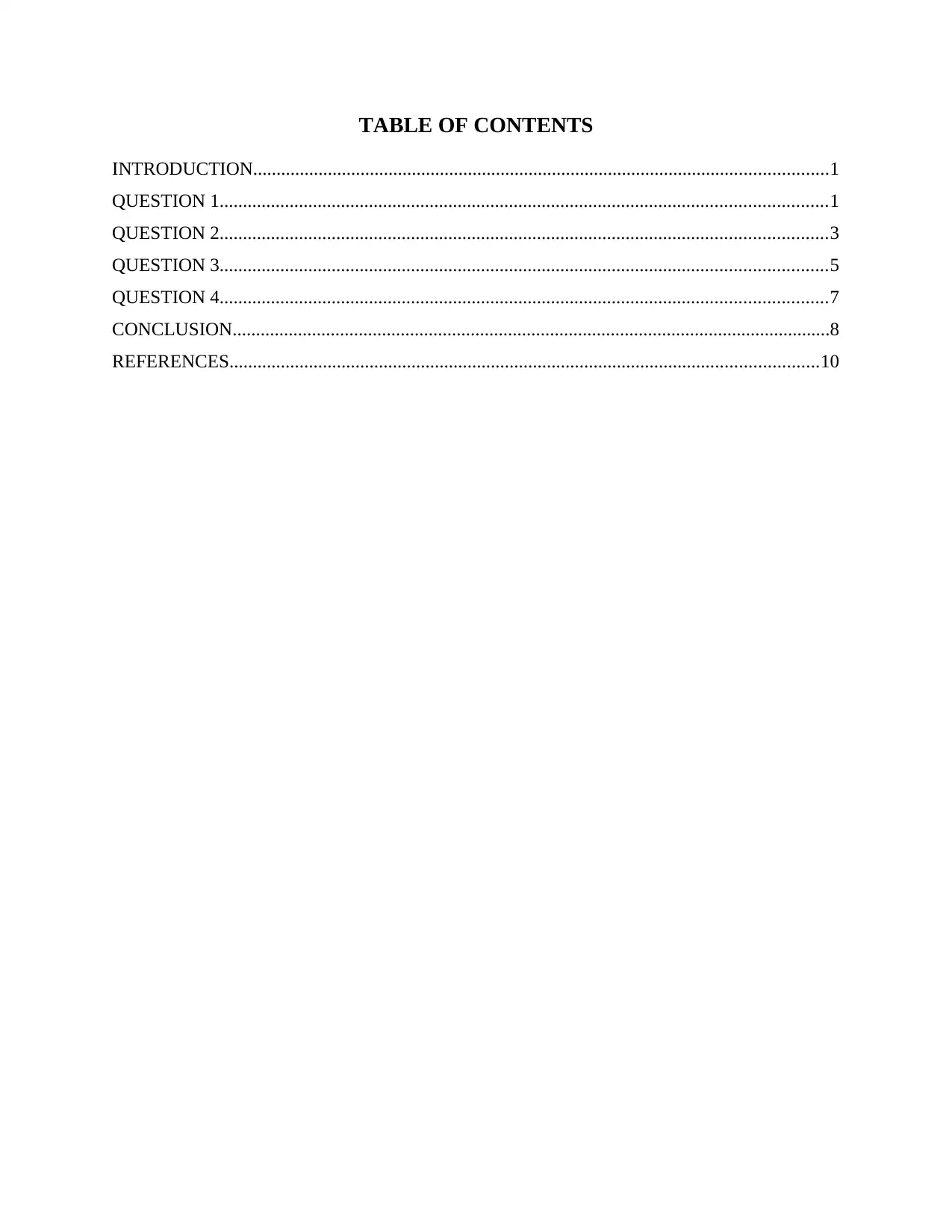
TABLE OF CONTENTS
INTRODUCTION...........................................................................................................................1
QUESTION 1..................................................................................................................................1
QUESTION 2..................................................................................................................................3
QUESTION 3..................................................................................................................................5
QUESTION 4..................................................................................................................................7
CONCLUSION................................................................................................................................8
REFERENCES..............................................................................................................................10
INTRODUCTION...........................................................................................................................1
QUESTION 1..................................................................................................................................1
QUESTION 2..................................................................................................................................3
QUESTION 3..................................................................................................................................5
QUESTION 4..................................................................................................................................7
CONCLUSION................................................................................................................................8
REFERENCES..............................................................................................................................10
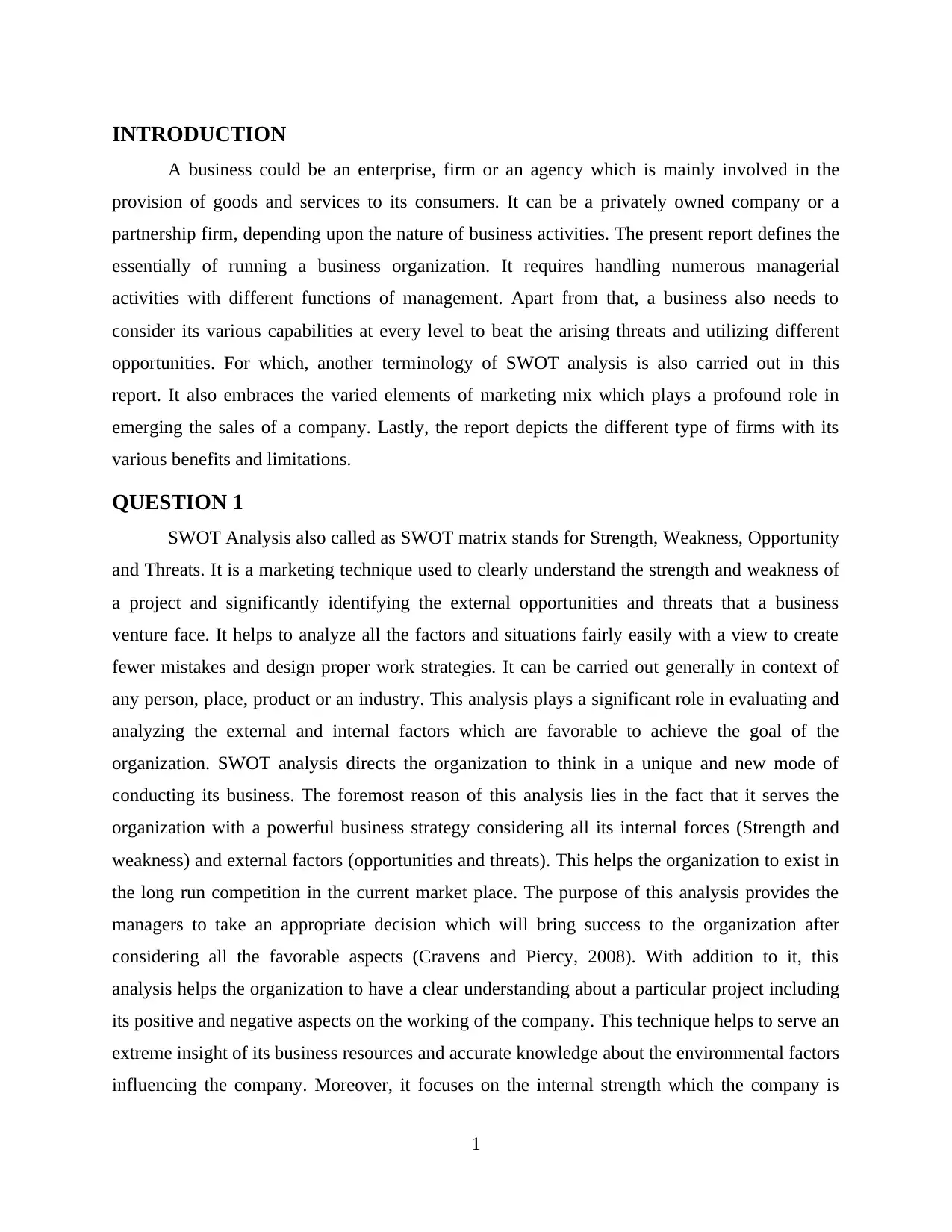
INTRODUCTION
A business could be an enterprise, firm or an agency which is mainly involved in the
provision of goods and services to its consumers. It can be a privately owned company or a
partnership firm, depending upon the nature of business activities. The present report defines the
essentially of running a business organization. It requires handling numerous managerial
activities with different functions of management. Apart from that, a business also needs to
consider its various capabilities at every level to beat the arising threats and utilizing different
opportunities. For which, another terminology of SWOT analysis is also carried out in this
report. It also embraces the varied elements of marketing mix which plays a profound role in
emerging the sales of a company. Lastly, the report depicts the different type of firms with its
various benefits and limitations.
QUESTION 1
SWOT Analysis also called as SWOT matrix stands for Strength, Weakness, Opportunity
and Threats. It is a marketing technique used to clearly understand the strength and weakness of
a project and significantly identifying the external opportunities and threats that a business
venture face. It helps to analyze all the factors and situations fairly easily with a view to create
fewer mistakes and design proper work strategies. It can be carried out generally in context of
any person, place, product or an industry. This analysis plays a significant role in evaluating and
analyzing the external and internal factors which are favorable to achieve the goal of the
organization. SWOT analysis directs the organization to think in a unique and new mode of
conducting its business. The foremost reason of this analysis lies in the fact that it serves the
organization with a powerful business strategy considering all its internal forces (Strength and
weakness) and external factors (opportunities and threats). This helps the organization to exist in
the long run competition in the current market place. The purpose of this analysis provides the
managers to take an appropriate decision which will bring success to the organization after
considering all the favorable aspects (Cravens and Piercy, 2008). With addition to it, this
analysis helps the organization to have a clear understanding about a particular project including
its positive and negative aspects on the working of the company. This technique helps to serve an
extreme insight of its business resources and accurate knowledge about the environmental factors
influencing the company. Moreover, it focuses on the internal strength which the company is
1
A business could be an enterprise, firm or an agency which is mainly involved in the
provision of goods and services to its consumers. It can be a privately owned company or a
partnership firm, depending upon the nature of business activities. The present report defines the
essentially of running a business organization. It requires handling numerous managerial
activities with different functions of management. Apart from that, a business also needs to
consider its various capabilities at every level to beat the arising threats and utilizing different
opportunities. For which, another terminology of SWOT analysis is also carried out in this
report. It also embraces the varied elements of marketing mix which plays a profound role in
emerging the sales of a company. Lastly, the report depicts the different type of firms with its
various benefits and limitations.
QUESTION 1
SWOT Analysis also called as SWOT matrix stands for Strength, Weakness, Opportunity
and Threats. It is a marketing technique used to clearly understand the strength and weakness of
a project and significantly identifying the external opportunities and threats that a business
venture face. It helps to analyze all the factors and situations fairly easily with a view to create
fewer mistakes and design proper work strategies. It can be carried out generally in context of
any person, place, product or an industry. This analysis plays a significant role in evaluating and
analyzing the external and internal factors which are favorable to achieve the goal of the
organization. SWOT analysis directs the organization to think in a unique and new mode of
conducting its business. The foremost reason of this analysis lies in the fact that it serves the
organization with a powerful business strategy considering all its internal forces (Strength and
weakness) and external factors (opportunities and threats). This helps the organization to exist in
the long run competition in the current market place. The purpose of this analysis provides the
managers to take an appropriate decision which will bring success to the organization after
considering all the favorable aspects (Cravens and Piercy, 2008). With addition to it, this
analysis helps the organization to have a clear understanding about a particular project including
its positive and negative aspects on the working of the company. This technique helps to serve an
extreme insight of its business resources and accurate knowledge about the environmental factors
influencing the company. Moreover, it focuses on the internal strength which the company is
1
⊘ This is a preview!⊘
Do you want full access?
Subscribe today to unlock all pages.

Trusted by 1+ million students worldwide
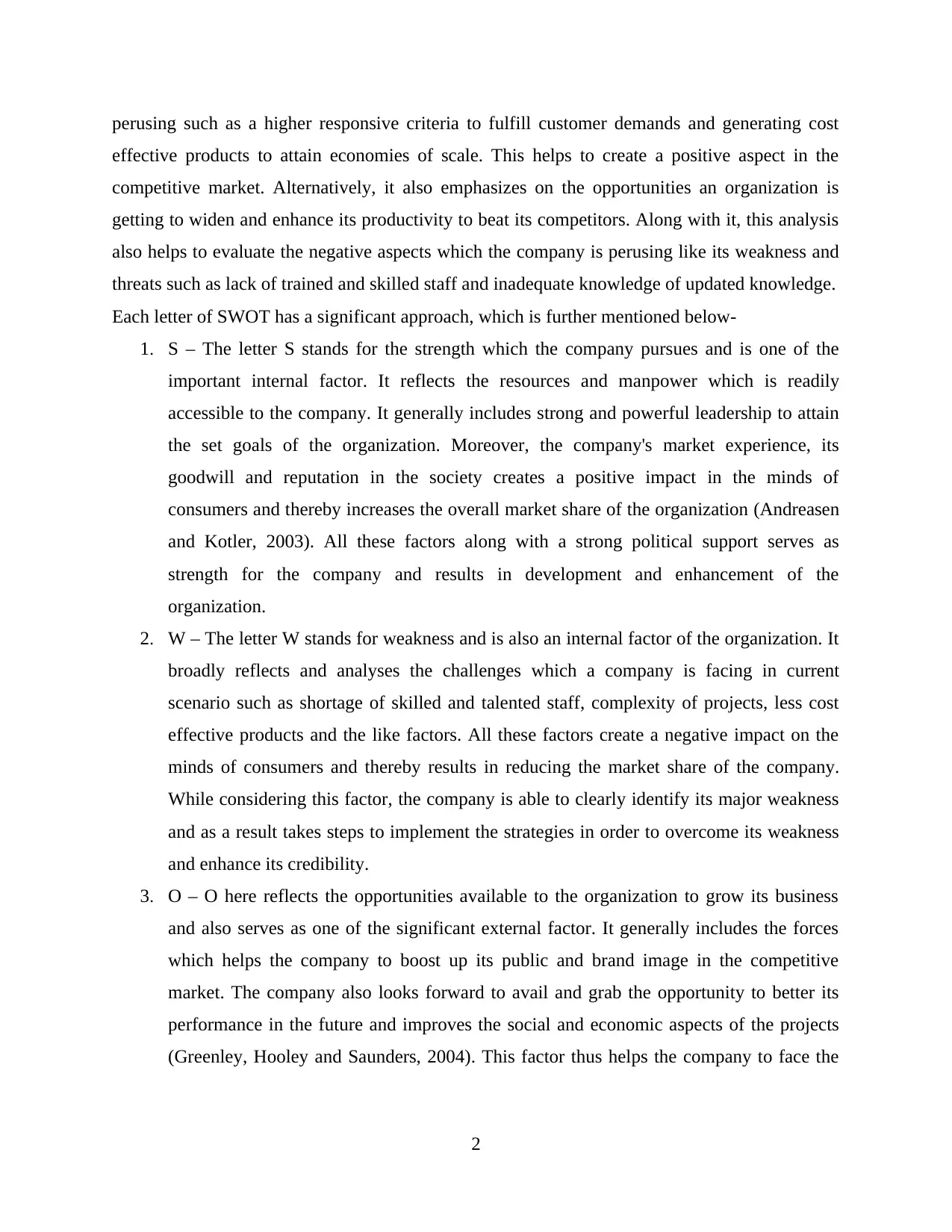
perusing such as a higher responsive criteria to fulfill customer demands and generating cost
effective products to attain economies of scale. This helps to create a positive aspect in the
competitive market. Alternatively, it also emphasizes on the opportunities an organization is
getting to widen and enhance its productivity to beat its competitors. Along with it, this analysis
also helps to evaluate the negative aspects which the company is perusing like its weakness and
threats such as lack of trained and skilled staff and inadequate knowledge of updated knowledge.
Each letter of SWOT has a significant approach, which is further mentioned below-
1. S – The letter S stands for the strength which the company pursues and is one of the
important internal factor. It reflects the resources and manpower which is readily
accessible to the company. It generally includes strong and powerful leadership to attain
the set goals of the organization. Moreover, the company's market experience, its
goodwill and reputation in the society creates a positive impact in the minds of
consumers and thereby increases the overall market share of the organization (Andreasen
and Kotler, 2003). All these factors along with a strong political support serves as
strength for the company and results in development and enhancement of the
organization.
2. W – The letter W stands for weakness and is also an internal factor of the organization. It
broadly reflects and analyses the challenges which a company is facing in current
scenario such as shortage of skilled and talented staff, complexity of projects, less cost
effective products and the like factors. All these factors create a negative impact on the
minds of consumers and thereby results in reducing the market share of the company.
While considering this factor, the company is able to clearly identify its major weakness
and as a result takes steps to implement the strategies in order to overcome its weakness
and enhance its credibility.
3. O – O here reflects the opportunities available to the organization to grow its business
and also serves as one of the significant external factor. It generally includes the forces
which helps the company to boost up its public and brand image in the competitive
market. The company also looks forward to avail and grab the opportunity to better its
performance in the future and improves the social and economic aspects of the projects
(Greenley, Hooley and Saunders, 2004). This factor thus helps the company to face the
2
effective products to attain economies of scale. This helps to create a positive aspect in the
competitive market. Alternatively, it also emphasizes on the opportunities an organization is
getting to widen and enhance its productivity to beat its competitors. Along with it, this analysis
also helps to evaluate the negative aspects which the company is perusing like its weakness and
threats such as lack of trained and skilled staff and inadequate knowledge of updated knowledge.
Each letter of SWOT has a significant approach, which is further mentioned below-
1. S – The letter S stands for the strength which the company pursues and is one of the
important internal factor. It reflects the resources and manpower which is readily
accessible to the company. It generally includes strong and powerful leadership to attain
the set goals of the organization. Moreover, the company's market experience, its
goodwill and reputation in the society creates a positive impact in the minds of
consumers and thereby increases the overall market share of the organization (Andreasen
and Kotler, 2003). All these factors along with a strong political support serves as
strength for the company and results in development and enhancement of the
organization.
2. W – The letter W stands for weakness and is also an internal factor of the organization. It
broadly reflects and analyses the challenges which a company is facing in current
scenario such as shortage of skilled and talented staff, complexity of projects, less cost
effective products and the like factors. All these factors create a negative impact on the
minds of consumers and thereby results in reducing the market share of the company.
While considering this factor, the company is able to clearly identify its major weakness
and as a result takes steps to implement the strategies in order to overcome its weakness
and enhance its credibility.
3. O – O here reflects the opportunities available to the organization to grow its business
and also serves as one of the significant external factor. It generally includes the forces
which helps the company to boost up its public and brand image in the competitive
market. The company also looks forward to avail and grab the opportunity to better its
performance in the future and improves the social and economic aspects of the projects
(Greenley, Hooley and Saunders, 2004). This factor thus helps the company to face the
2
Paraphrase This Document
Need a fresh take? Get an instant paraphrase of this document with our AI Paraphraser
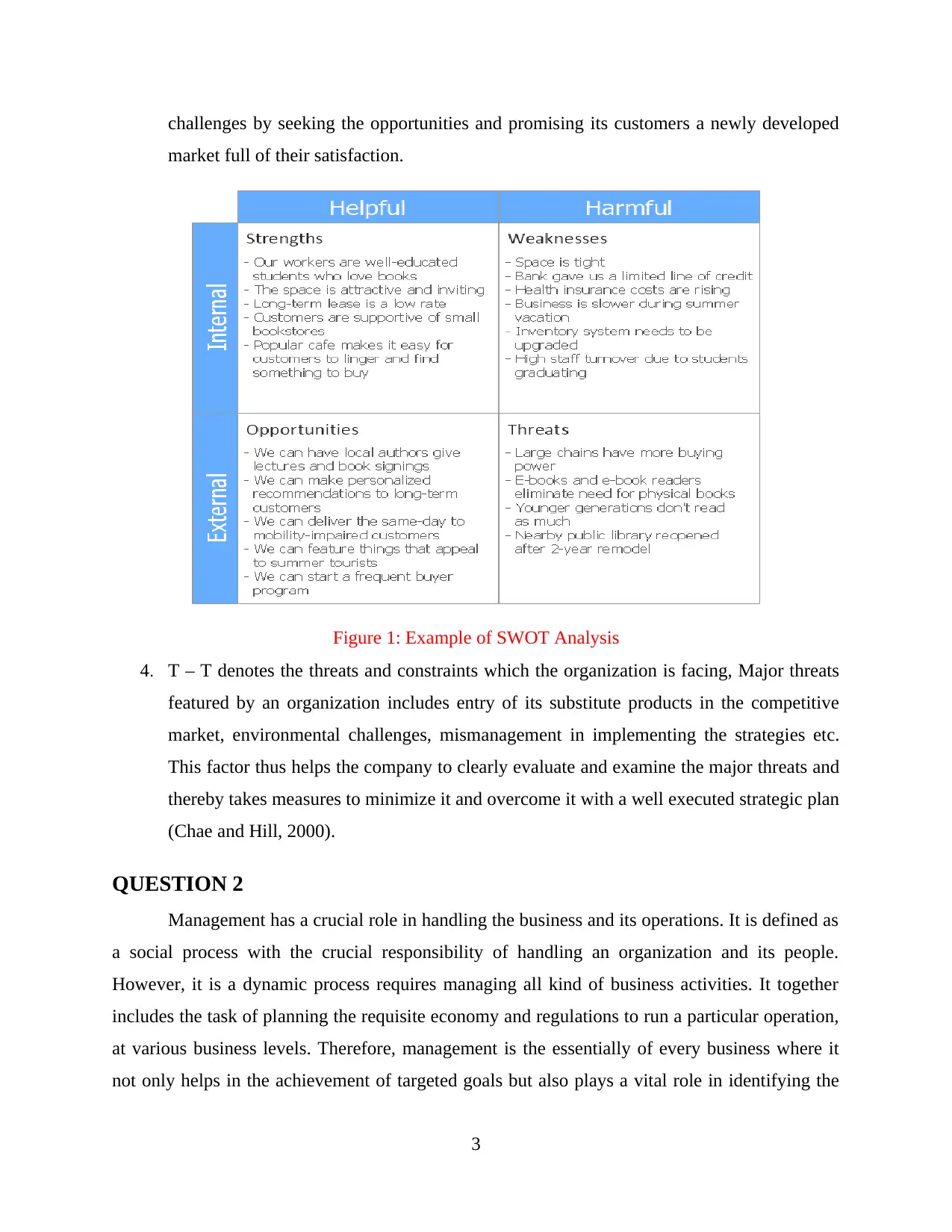
challenges by seeking the opportunities and promising its customers a newly developed
market full of their satisfaction.
Figure 1: Example of SWOT Analysis
4. T – T denotes the threats and constraints which the organization is facing, Major threats
featured by an organization includes entry of its substitute products in the competitive
market, environmental challenges, mismanagement in implementing the strategies etc.
This factor thus helps the company to clearly evaluate and examine the major threats and
thereby takes measures to minimize it and overcome it with a well executed strategic plan
(Chae and Hill, 2000).
QUESTION 2
Management has a crucial role in handling the business and its operations. It is defined as
a social process with the crucial responsibility of handling an organization and its people.
However, it is a dynamic process requires managing all kind of business activities. It together
includes the task of planning the requisite economy and regulations to run a particular operation,
at various business levels. Therefore, management is the essentially of every business where it
not only helps in the achievement of targeted goals but also plays a vital role in identifying the
3
market full of their satisfaction.
Figure 1: Example of SWOT Analysis
4. T – T denotes the threats and constraints which the organization is facing, Major threats
featured by an organization includes entry of its substitute products in the competitive
market, environmental challenges, mismanagement in implementing the strategies etc.
This factor thus helps the company to clearly evaluate and examine the major threats and
thereby takes measures to minimize it and overcome it with a well executed strategic plan
(Chae and Hill, 2000).
QUESTION 2
Management has a crucial role in handling the business and its operations. It is defined as
a social process with the crucial responsibility of handling an organization and its people.
However, it is a dynamic process requires managing all kind of business activities. It together
includes the task of planning the requisite economy and regulations to run a particular operation,
at various business levels. Therefore, management is the essentially of every business where it
not only helps in the achievement of targeted goals but also plays a vital role in identifying the
3
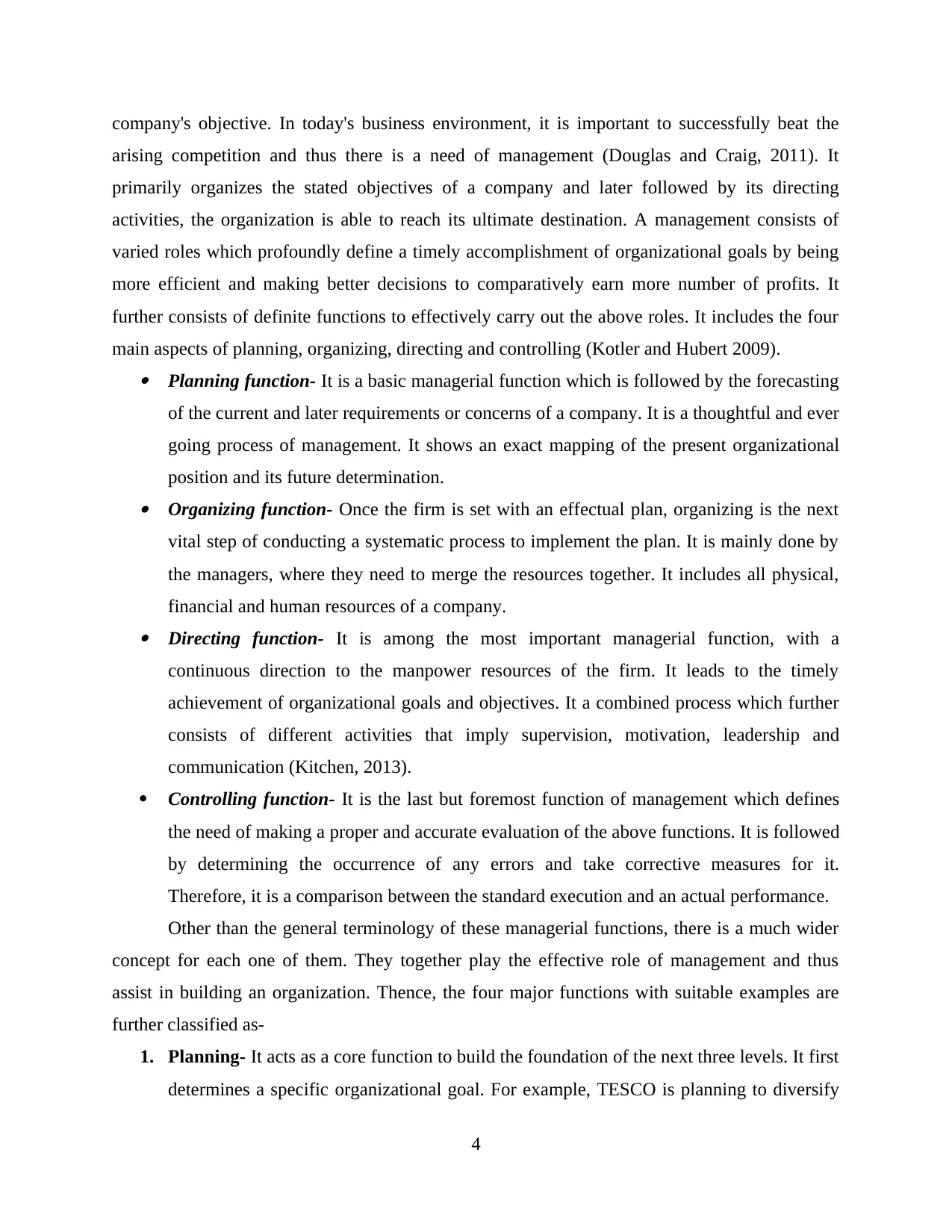
company's objective. In today's business environment, it is important to successfully beat the
arising competition and thus there is a need of management (Douglas and Craig, 2011). It
primarily organizes the stated objectives of a company and later followed by its directing
activities, the organization is able to reach its ultimate destination. A management consists of
varied roles which profoundly define a timely accomplishment of organizational goals by being
more efficient and making better decisions to comparatively earn more number of profits. It
further consists of definite functions to effectively carry out the above roles. It includes the four
main aspects of planning, organizing, directing and controlling (Kotler and Hubert 2009). Planning function- It is a basic managerial function which is followed by the forecasting
of the current and later requirements or concerns of a company. It is a thoughtful and ever
going process of management. It shows an exact mapping of the present organizational
position and its future determination. Organizing function- Once the firm is set with an effectual plan, organizing is the next
vital step of conducting a systematic process to implement the plan. It is mainly done by
the managers, where they need to merge the resources together. It includes all physical,
financial and human resources of a company. Directing function- It is among the most important managerial function, with a
continuous direction to the manpower resources of the firm. It leads to the timely
achievement of organizational goals and objectives. It a combined process which further
consists of different activities that imply supervision, motivation, leadership and
communication (Kitchen, 2013).
Controlling function- It is the last but foremost function of management which defines
the need of making a proper and accurate evaluation of the above functions. It is followed
by determining the occurrence of any errors and take corrective measures for it.
Therefore, it is a comparison between the standard execution and an actual performance.
Other than the general terminology of these managerial functions, there is a much wider
concept for each one of them. They together play the effective role of management and thus
assist in building an organization. Thence, the four major functions with suitable examples are
further classified as-
1. Planning- It acts as a core function to build the foundation of the next three levels. It first
determines a specific organizational goal. For example, TESCO is planning to diversify
4
arising competition and thus there is a need of management (Douglas and Craig, 2011). It
primarily organizes the stated objectives of a company and later followed by its directing
activities, the organization is able to reach its ultimate destination. A management consists of
varied roles which profoundly define a timely accomplishment of organizational goals by being
more efficient and making better decisions to comparatively earn more number of profits. It
further consists of definite functions to effectively carry out the above roles. It includes the four
main aspects of planning, organizing, directing and controlling (Kotler and Hubert 2009). Planning function- It is a basic managerial function which is followed by the forecasting
of the current and later requirements or concerns of a company. It is a thoughtful and ever
going process of management. It shows an exact mapping of the present organizational
position and its future determination. Organizing function- Once the firm is set with an effectual plan, organizing is the next
vital step of conducting a systematic process to implement the plan. It is mainly done by
the managers, where they need to merge the resources together. It includes all physical,
financial and human resources of a company. Directing function- It is among the most important managerial function, with a
continuous direction to the manpower resources of the firm. It leads to the timely
achievement of organizational goals and objectives. It a combined process which further
consists of different activities that imply supervision, motivation, leadership and
communication (Kitchen, 2013).
Controlling function- It is the last but foremost function of management which defines
the need of making a proper and accurate evaluation of the above functions. It is followed
by determining the occurrence of any errors and take corrective measures for it.
Therefore, it is a comparison between the standard execution and an actual performance.
Other than the general terminology of these managerial functions, there is a much wider
concept for each one of them. They together play the effective role of management and thus
assist in building an organization. Thence, the four major functions with suitable examples are
further classified as-
1. Planning- It acts as a core function to build the foundation of the next three levels. It first
determines a specific organizational goal. For example, TESCO is planning to diversify
4
⊘ This is a preview!⊘
Do you want full access?
Subscribe today to unlock all pages.

Trusted by 1+ million students worldwide
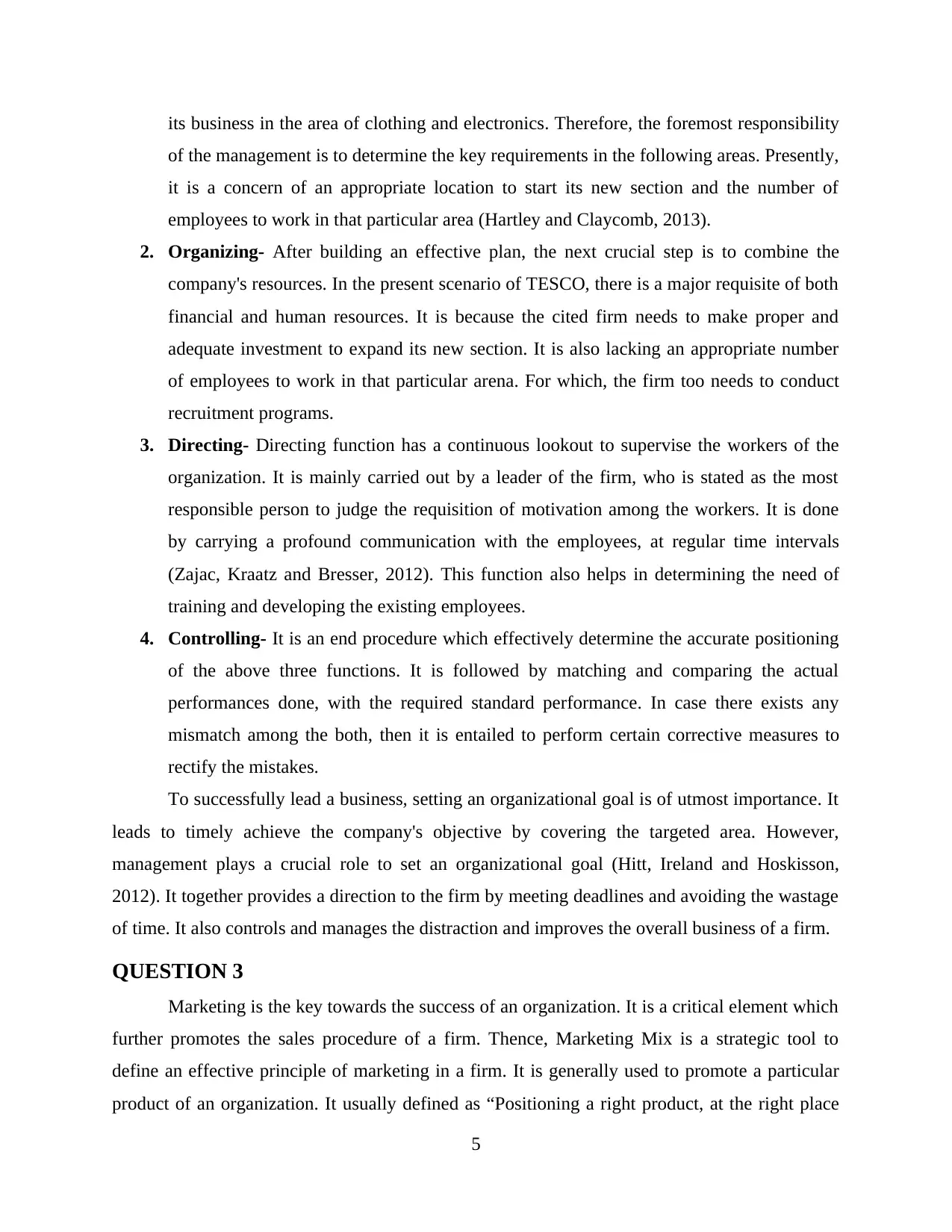
its business in the area of clothing and electronics. Therefore, the foremost responsibility
of the management is to determine the key requirements in the following areas. Presently,
it is a concern of an appropriate location to start its new section and the number of
employees to work in that particular area (Hartley and Claycomb, 2013).
2. Organizing- After building an effective plan, the next crucial step is to combine the
company's resources. In the present scenario of TESCO, there is a major requisite of both
financial and human resources. It is because the cited firm needs to make proper and
adequate investment to expand its new section. It is also lacking an appropriate number
of employees to work in that particular arena. For which, the firm too needs to conduct
recruitment programs.
3. Directing- Directing function has a continuous lookout to supervise the workers of the
organization. It is mainly carried out by a leader of the firm, who is stated as the most
responsible person to judge the requisition of motivation among the workers. It is done
by carrying a profound communication with the employees, at regular time intervals
(Zajac, Kraatz and Bresser, 2012). This function also helps in determining the need of
training and developing the existing employees.
4. Controlling- It is an end procedure which effectively determine the accurate positioning
of the above three functions. It is followed by matching and comparing the actual
performances done, with the required standard performance. In case there exists any
mismatch among the both, then it is entailed to perform certain corrective measures to
rectify the mistakes.
To successfully lead a business, setting an organizational goal is of utmost importance. It
leads to timely achieve the company's objective by covering the targeted area. However,
management plays a crucial role to set an organizational goal (Hitt, Ireland and Hoskisson,
2012). It together provides a direction to the firm by meeting deadlines and avoiding the wastage
of time. It also controls and manages the distraction and improves the overall business of a firm.
QUESTION 3
Marketing is the key towards the success of an organization. It is a critical element which
further promotes the sales procedure of a firm. Thence, Marketing Mix is a strategic tool to
define an effective principle of marketing in a firm. It is generally used to promote a particular
product of an organization. It usually defined as “Positioning a right product, at the right place
5
of the management is to determine the key requirements in the following areas. Presently,
it is a concern of an appropriate location to start its new section and the number of
employees to work in that particular area (Hartley and Claycomb, 2013).
2. Organizing- After building an effective plan, the next crucial step is to combine the
company's resources. In the present scenario of TESCO, there is a major requisite of both
financial and human resources. It is because the cited firm needs to make proper and
adequate investment to expand its new section. It is also lacking an appropriate number
of employees to work in that particular arena. For which, the firm too needs to conduct
recruitment programs.
3. Directing- Directing function has a continuous lookout to supervise the workers of the
organization. It is mainly carried out by a leader of the firm, who is stated as the most
responsible person to judge the requisition of motivation among the workers. It is done
by carrying a profound communication with the employees, at regular time intervals
(Zajac, Kraatz and Bresser, 2012). This function also helps in determining the need of
training and developing the existing employees.
4. Controlling- It is an end procedure which effectively determine the accurate positioning
of the above three functions. It is followed by matching and comparing the actual
performances done, with the required standard performance. In case there exists any
mismatch among the both, then it is entailed to perform certain corrective measures to
rectify the mistakes.
To successfully lead a business, setting an organizational goal is of utmost importance. It
leads to timely achieve the company's objective by covering the targeted area. However,
management plays a crucial role to set an organizational goal (Hitt, Ireland and Hoskisson,
2012). It together provides a direction to the firm by meeting deadlines and avoiding the wastage
of time. It also controls and manages the distraction and improves the overall business of a firm.
QUESTION 3
Marketing is the key towards the success of an organization. It is a critical element which
further promotes the sales procedure of a firm. Thence, Marketing Mix is a strategic tool to
define an effective principle of marketing in a firm. It is generally used to promote a particular
product of an organization. It usually defined as “Positioning a right product, at the right place
5
Paraphrase This Document
Need a fresh take? Get an instant paraphrase of this document with our AI Paraphraser
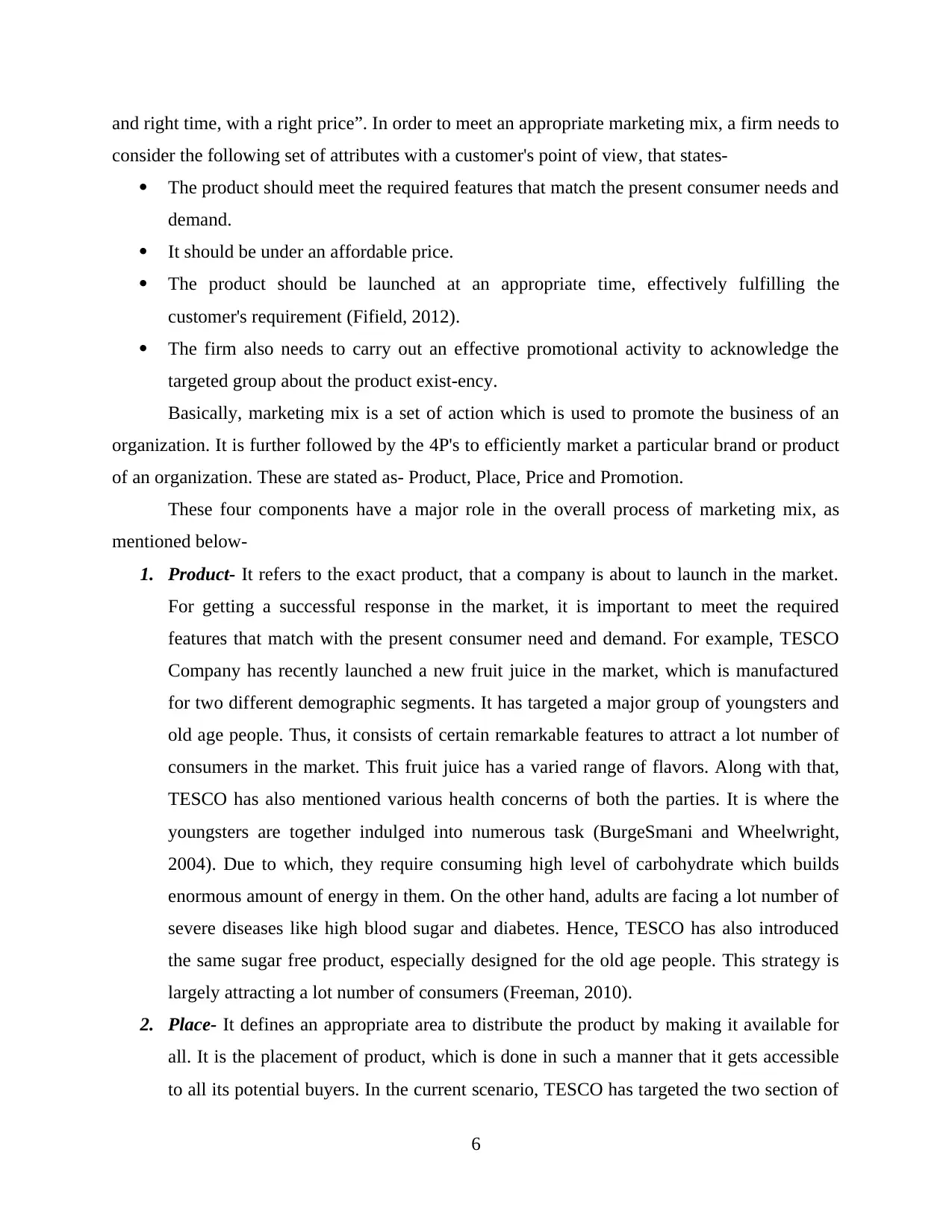
and right time, with a right price”. In order to meet an appropriate marketing mix, a firm needs to
consider the following set of attributes with a customer's point of view, that states-
The product should meet the required features that match the present consumer needs and
demand.
It should be under an affordable price.
The product should be launched at an appropriate time, effectively fulfilling the
customer's requirement (Fifield, 2012).
The firm also needs to carry out an effective promotional activity to acknowledge the
targeted group about the product exist-ency.
Basically, marketing mix is a set of action which is used to promote the business of an
organization. It is further followed by the 4P's to efficiently market a particular brand or product
of an organization. These are stated as- Product, Place, Price and Promotion.
These four components have a major role in the overall process of marketing mix, as
mentioned below-
1. Product- It refers to the exact product, that a company is about to launch in the market.
For getting a successful response in the market, it is important to meet the required
features that match with the present consumer need and demand. For example, TESCO
Company has recently launched a new fruit juice in the market, which is manufactured
for two different demographic segments. It has targeted a major group of youngsters and
old age people. Thus, it consists of certain remarkable features to attract a lot number of
consumers in the market. This fruit juice has a varied range of flavors. Along with that,
TESCO has also mentioned various health concerns of both the parties. It is where the
youngsters are together indulged into numerous task (BurgeSmani and Wheelwright,
2004). Due to which, they require consuming high level of carbohydrate which builds
enormous amount of energy in them. On the other hand, adults are facing a lot number of
severe diseases like high blood sugar and diabetes. Hence, TESCO has also introduced
the same sugar free product, especially designed for the old age people. This strategy is
largely attracting a lot number of consumers (Freeman, 2010).
2. Place- It defines an appropriate area to distribute the product by making it available for
all. It is the placement of product, which is done in such a manner that it gets accessible
to all its potential buyers. In the current scenario, TESCO has targeted the two section of
6
consider the following set of attributes with a customer's point of view, that states-
The product should meet the required features that match the present consumer needs and
demand.
It should be under an affordable price.
The product should be launched at an appropriate time, effectively fulfilling the
customer's requirement (Fifield, 2012).
The firm also needs to carry out an effective promotional activity to acknowledge the
targeted group about the product exist-ency.
Basically, marketing mix is a set of action which is used to promote the business of an
organization. It is further followed by the 4P's to efficiently market a particular brand or product
of an organization. These are stated as- Product, Place, Price and Promotion.
These four components have a major role in the overall process of marketing mix, as
mentioned below-
1. Product- It refers to the exact product, that a company is about to launch in the market.
For getting a successful response in the market, it is important to meet the required
features that match with the present consumer need and demand. For example, TESCO
Company has recently launched a new fruit juice in the market, which is manufactured
for two different demographic segments. It has targeted a major group of youngsters and
old age people. Thus, it consists of certain remarkable features to attract a lot number of
consumers in the market. This fruit juice has a varied range of flavors. Along with that,
TESCO has also mentioned various health concerns of both the parties. It is where the
youngsters are together indulged into numerous task (BurgeSmani and Wheelwright,
2004). Due to which, they require consuming high level of carbohydrate which builds
enormous amount of energy in them. On the other hand, adults are facing a lot number of
severe diseases like high blood sugar and diabetes. Hence, TESCO has also introduced
the same sugar free product, especially designed for the old age people. This strategy is
largely attracting a lot number of consumers (Freeman, 2010).
2. Place- It defines an appropriate area to distribute the product by making it available for
all. It is the placement of product, which is done in such a manner that it gets accessible
to all its potential buyers. In the current scenario, TESCO has targeted the two section of
6
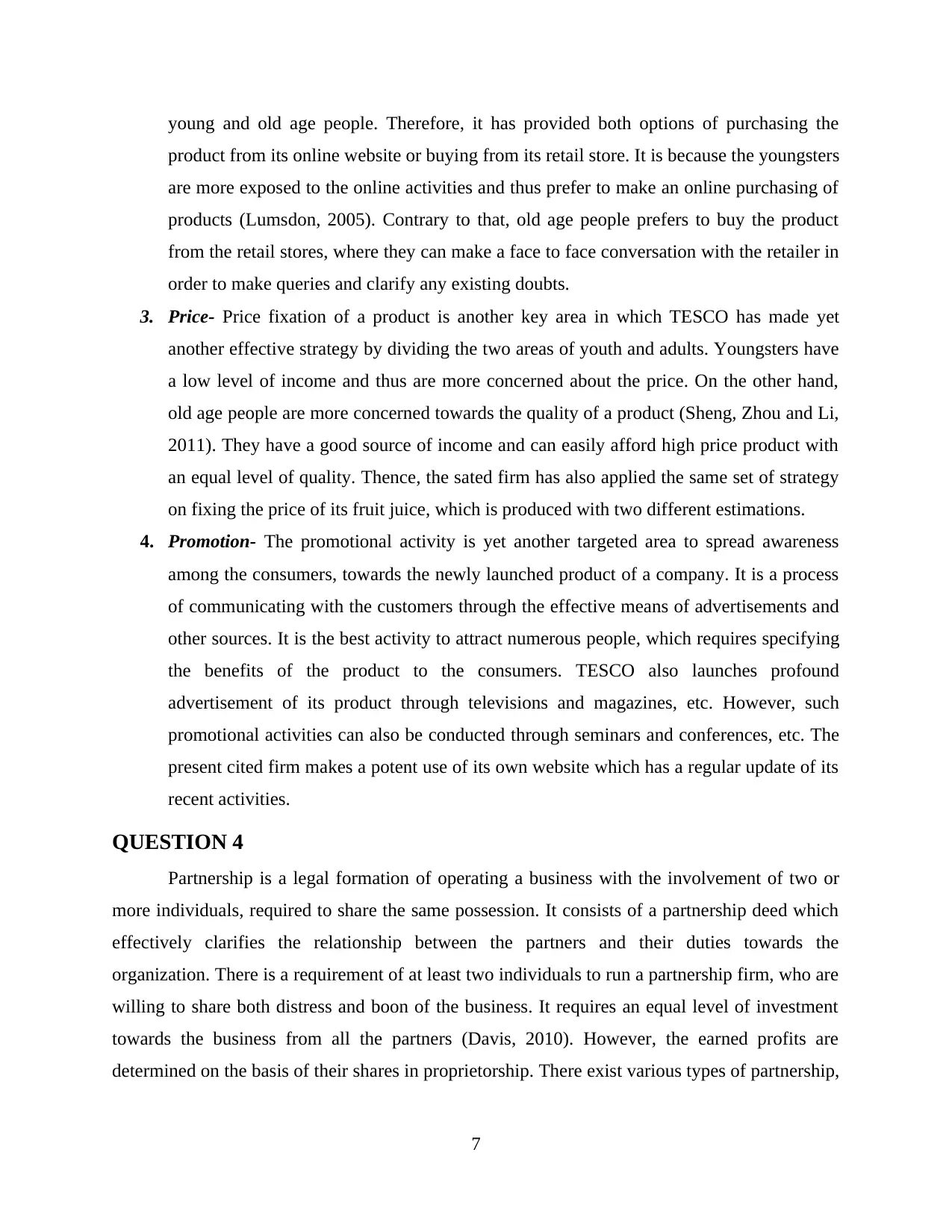
young and old age people. Therefore, it has provided both options of purchasing the
product from its online website or buying from its retail store. It is because the youngsters
are more exposed to the online activities and thus prefer to make an online purchasing of
products (Lumsdon, 2005). Contrary to that, old age people prefers to buy the product
from the retail stores, where they can make a face to face conversation with the retailer in
order to make queries and clarify any existing doubts.
3. Price- Price fixation of a product is another key area in which TESCO has made yet
another effective strategy by dividing the two areas of youth and adults. Youngsters have
a low level of income and thus are more concerned about the price. On the other hand,
old age people are more concerned towards the quality of a product (Sheng, Zhou and Li,
2011). They have a good source of income and can easily afford high price product with
an equal level of quality. Thence, the sated firm has also applied the same set of strategy
on fixing the price of its fruit juice, which is produced with two different estimations.
4. Promotion- The promotional activity is yet another targeted area to spread awareness
among the consumers, towards the newly launched product of a company. It is a process
of communicating with the customers through the effective means of advertisements and
other sources. It is the best activity to attract numerous people, which requires specifying
the benefits of the product to the consumers. TESCO also launches profound
advertisement of its product through televisions and magazines, etc. However, such
promotional activities can also be conducted through seminars and conferences, etc. The
present cited firm makes a potent use of its own website which has a regular update of its
recent activities.
QUESTION 4
Partnership is a legal formation of operating a business with the involvement of two or
more individuals, required to share the same possession. It consists of a partnership deed which
effectively clarifies the relationship between the partners and their duties towards the
organization. There is a requirement of at least two individuals to run a partnership firm, who are
willing to share both distress and boon of the business. It requires an equal level of investment
towards the business from all the partners (Davis, 2010). However, the earned profits are
determined on the basis of their shares in proprietorship. There exist various types of partnership,
7
product from its online website or buying from its retail store. It is because the youngsters
are more exposed to the online activities and thus prefer to make an online purchasing of
products (Lumsdon, 2005). Contrary to that, old age people prefers to buy the product
from the retail stores, where they can make a face to face conversation with the retailer in
order to make queries and clarify any existing doubts.
3. Price- Price fixation of a product is another key area in which TESCO has made yet
another effective strategy by dividing the two areas of youth and adults. Youngsters have
a low level of income and thus are more concerned about the price. On the other hand,
old age people are more concerned towards the quality of a product (Sheng, Zhou and Li,
2011). They have a good source of income and can easily afford high price product with
an equal level of quality. Thence, the sated firm has also applied the same set of strategy
on fixing the price of its fruit juice, which is produced with two different estimations.
4. Promotion- The promotional activity is yet another targeted area to spread awareness
among the consumers, towards the newly launched product of a company. It is a process
of communicating with the customers through the effective means of advertisements and
other sources. It is the best activity to attract numerous people, which requires specifying
the benefits of the product to the consumers. TESCO also launches profound
advertisement of its product through televisions and magazines, etc. However, such
promotional activities can also be conducted through seminars and conferences, etc. The
present cited firm makes a potent use of its own website which has a regular update of its
recent activities.
QUESTION 4
Partnership is a legal formation of operating a business with the involvement of two or
more individuals, required to share the same possession. It consists of a partnership deed which
effectively clarifies the relationship between the partners and their duties towards the
organization. There is a requirement of at least two individuals to run a partnership firm, who are
willing to share both distress and boon of the business. It requires an equal level of investment
towards the business from all the partners (Davis, 2010). However, the earned profits are
determined on the basis of their shares in proprietorship. There exist various types of partnership,
7
⊘ This is a preview!⊘
Do you want full access?
Subscribe today to unlock all pages.

Trusted by 1+ million students worldwide
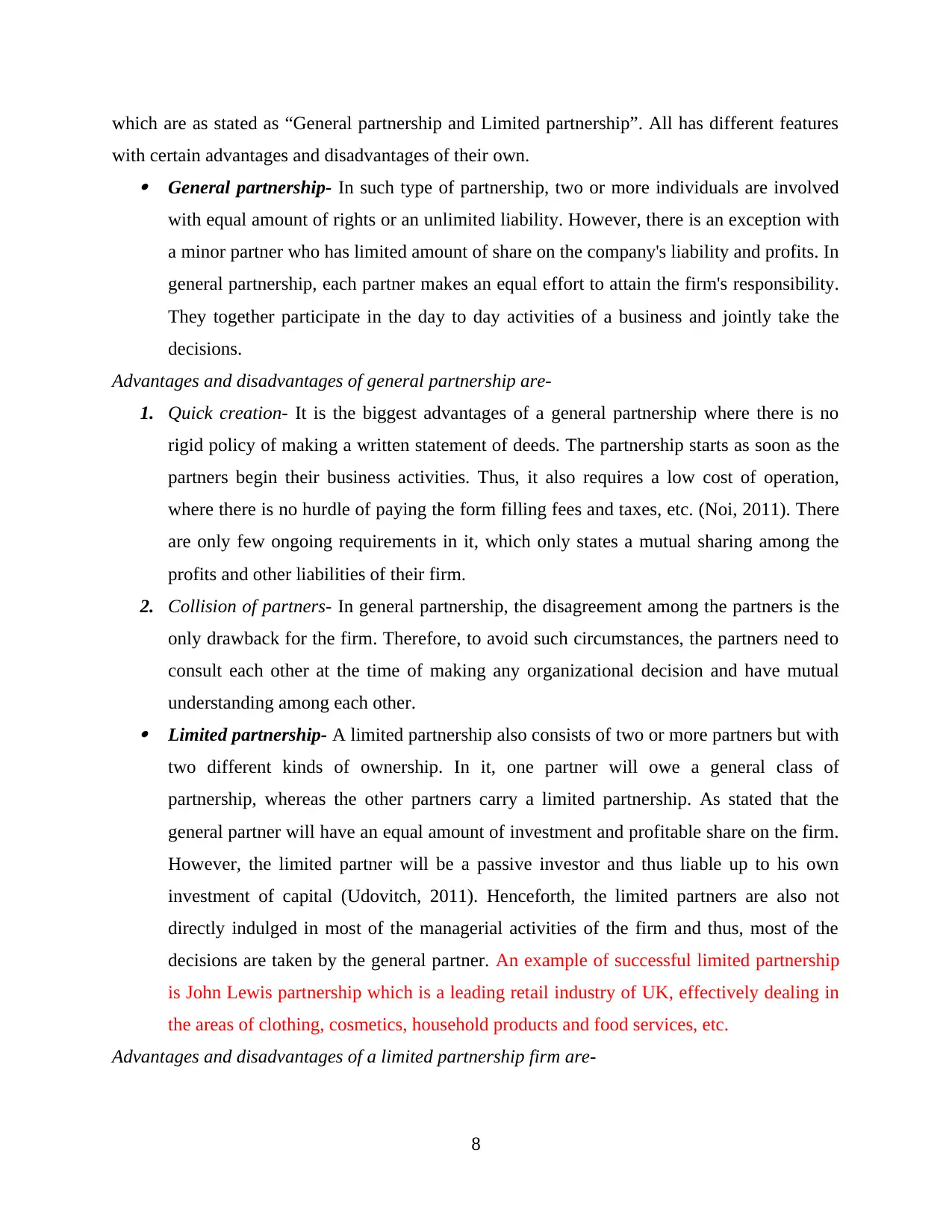
which are as stated as “General partnership and Limited partnership”. All has different features
with certain advantages and disadvantages of their own. General partnership- In such type of partnership, two or more individuals are involved
with equal amount of rights or an unlimited liability. However, there is an exception with
a minor partner who has limited amount of share on the company's liability and profits. In
general partnership, each partner makes an equal effort to attain the firm's responsibility.
They together participate in the day to day activities of a business and jointly take the
decisions.
Advantages and disadvantages of general partnership are-
1. Quick creation- It is the biggest advantages of a general partnership where there is no
rigid policy of making a written statement of deeds. The partnership starts as soon as the
partners begin their business activities. Thus, it also requires a low cost of operation,
where there is no hurdle of paying the form filling fees and taxes, etc. (Noi, 2011). There
are only few ongoing requirements in it, which only states a mutual sharing among the
profits and other liabilities of their firm.
2. Collision of partners- In general partnership, the disagreement among the partners is the
only drawback for the firm. Therefore, to avoid such circumstances, the partners need to
consult each other at the time of making any organizational decision and have mutual
understanding among each other. Limited partnership- A limited partnership also consists of two or more partners but with
two different kinds of ownership. In it, one partner will owe a general class of
partnership, whereas the other partners carry a limited partnership. As stated that the
general partner will have an equal amount of investment and profitable share on the firm.
However, the limited partner will be a passive investor and thus liable up to his own
investment of capital (Udovitch, 2011). Henceforth, the limited partners are also not
directly indulged in most of the managerial activities of the firm and thus, most of the
decisions are taken by the general partner. An example of successful limited partnership
is John Lewis partnership which is a leading retail industry of UK, effectively dealing in
the areas of clothing, cosmetics, household products and food services, etc.
Advantages and disadvantages of a limited partnership firm are-
8
with certain advantages and disadvantages of their own. General partnership- In such type of partnership, two or more individuals are involved
with equal amount of rights or an unlimited liability. However, there is an exception with
a minor partner who has limited amount of share on the company's liability and profits. In
general partnership, each partner makes an equal effort to attain the firm's responsibility.
They together participate in the day to day activities of a business and jointly take the
decisions.
Advantages and disadvantages of general partnership are-
1. Quick creation- It is the biggest advantages of a general partnership where there is no
rigid policy of making a written statement of deeds. The partnership starts as soon as the
partners begin their business activities. Thus, it also requires a low cost of operation,
where there is no hurdle of paying the form filling fees and taxes, etc. (Noi, 2011). There
are only few ongoing requirements in it, which only states a mutual sharing among the
profits and other liabilities of their firm.
2. Collision of partners- In general partnership, the disagreement among the partners is the
only drawback for the firm. Therefore, to avoid such circumstances, the partners need to
consult each other at the time of making any organizational decision and have mutual
understanding among each other. Limited partnership- A limited partnership also consists of two or more partners but with
two different kinds of ownership. In it, one partner will owe a general class of
partnership, whereas the other partners carry a limited partnership. As stated that the
general partner will have an equal amount of investment and profitable share on the firm.
However, the limited partner will be a passive investor and thus liable up to his own
investment of capital (Udovitch, 2011). Henceforth, the limited partners are also not
directly indulged in most of the managerial activities of the firm and thus, most of the
decisions are taken by the general partner. An example of successful limited partnership
is John Lewis partnership which is a leading retail industry of UK, effectively dealing in
the areas of clothing, cosmetics, household products and food services, etc.
Advantages and disadvantages of a limited partnership firm are-
8
Paraphrase This Document
Need a fresh take? Get an instant paraphrase of this document with our AI Paraphraser
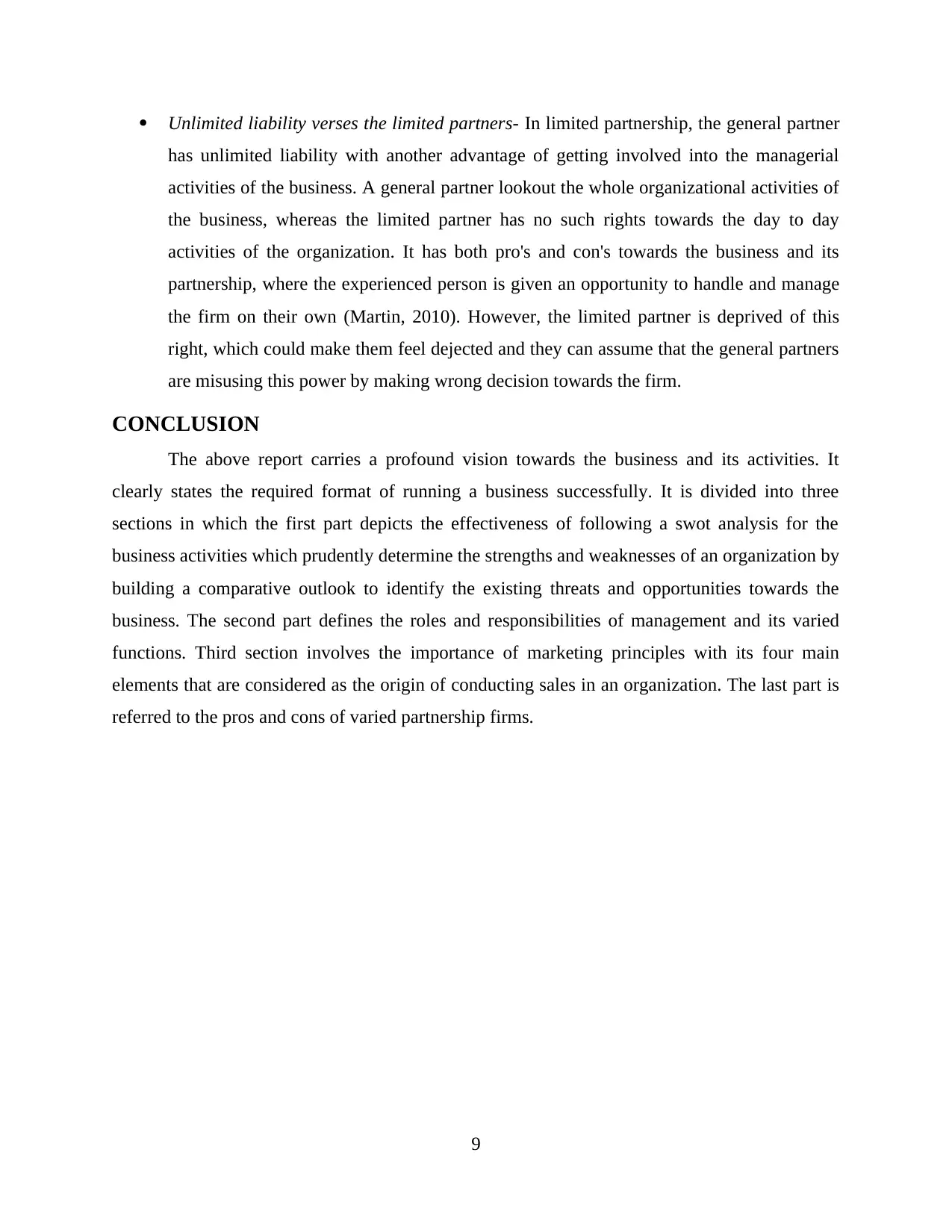
Unlimited liability verses the limited partners- In limited partnership, the general partner
has unlimited liability with another advantage of getting involved into the managerial
activities of the business. A general partner lookout the whole organizational activities of
the business, whereas the limited partner has no such rights towards the day to day
activities of the organization. It has both pro's and con's towards the business and its
partnership, where the experienced person is given an opportunity to handle and manage
the firm on their own (Martin, 2010). However, the limited partner is deprived of this
right, which could make them feel dejected and they can assume that the general partners
are misusing this power by making wrong decision towards the firm.
CONCLUSION
The above report carries a profound vision towards the business and its activities. It
clearly states the required format of running a business successfully. It is divided into three
sections in which the first part depicts the effectiveness of following a swot analysis for the
business activities which prudently determine the strengths and weaknesses of an organization by
building a comparative outlook to identify the existing threats and opportunities towards the
business. The second part defines the roles and responsibilities of management and its varied
functions. Third section involves the importance of marketing principles with its four main
elements that are considered as the origin of conducting sales in an organization. The last part is
referred to the pros and cons of varied partnership firms.
9
has unlimited liability with another advantage of getting involved into the managerial
activities of the business. A general partner lookout the whole organizational activities of
the business, whereas the limited partner has no such rights towards the day to day
activities of the organization. It has both pro's and con's towards the business and its
partnership, where the experienced person is given an opportunity to handle and manage
the firm on their own (Martin, 2010). However, the limited partner is deprived of this
right, which could make them feel dejected and they can assume that the general partners
are misusing this power by making wrong decision towards the firm.
CONCLUSION
The above report carries a profound vision towards the business and its activities. It
clearly states the required format of running a business successfully. It is divided into three
sections in which the first part depicts the effectiveness of following a swot analysis for the
business activities which prudently determine the strengths and weaknesses of an organization by
building a comparative outlook to identify the existing threats and opportunities towards the
business. The second part defines the roles and responsibilities of management and its varied
functions. Third section involves the importance of marketing principles with its four main
elements that are considered as the origin of conducting sales in an organization. The last part is
referred to the pros and cons of varied partnership firms.
9
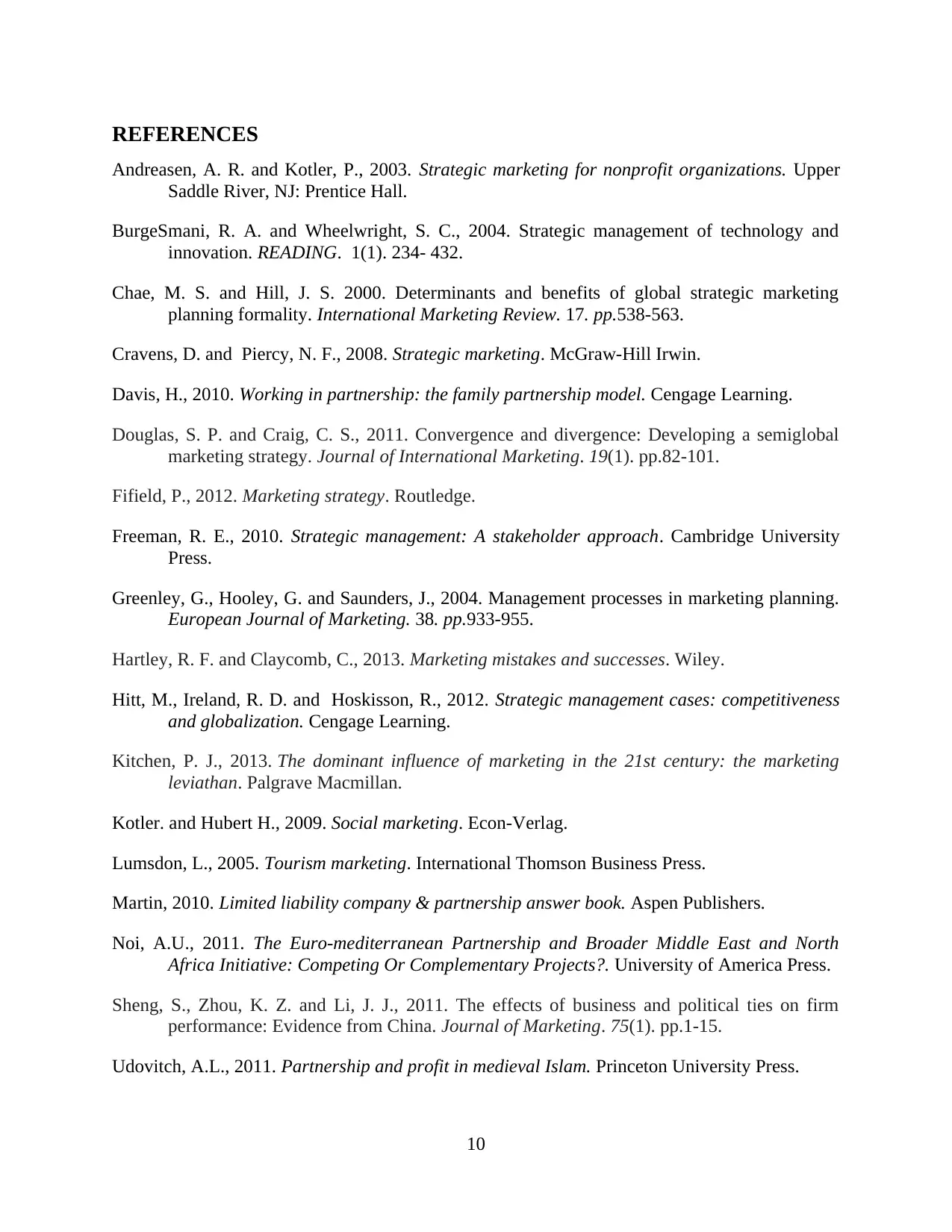
REFERENCES
Andreasen, A. R. and Kotler, P., 2003. Strategic marketing for nonprofit organizations. Upper
Saddle River, NJ: Prentice Hall.
BurgeSmani, R. A. and Wheelwright, S. C., 2004. Strategic management of technology and
innovation. READING. 1(1). 234- 432.
Chae, M. S. and Hill, J. S. 2000. Determinants and benefits of global strategic marketing
planning formality. International Marketing Review. 17. pp.538-563.
Cravens, D. and Piercy, N. F., 2008. Strategic marketing. McGraw-Hill Irwin.
Davis, H., 2010. Working in partnership: the family partnership model. Cengage Learning.
Douglas, S. P. and Craig, C. S., 2011. Convergence and divergence: Developing a semiglobal
marketing strategy. Journal of International Marketing. 19(1). pp.82-101.
Fifield, P., 2012. Marketing strategy. Routledge.
Freeman, R. E., 2010. Strategic management: A stakeholder approach. Cambridge University
Press.
Greenley, G., Hooley, G. and Saunders, J., 2004. Management processes in marketing planning.
European Journal of Marketing. 38. pp.933-955.
Hartley, R. F. and Claycomb, C., 2013. Marketing mistakes and successes. Wiley.
Hitt, M., Ireland, R. D. and Hoskisson, R., 2012. Strategic management cases: competitiveness
and globalization. Cengage Learning.
Kitchen, P. J., 2013. The dominant influence of marketing in the 21st century: the marketing
leviathan. Palgrave Macmillan.
Kotler. and Hubert H., 2009. Social marketing. Econ-Verlag.
Lumsdon, L., 2005. Tourism marketing. International Thomson Business Press.
Martin, 2010. Limited liability company & partnership answer book. Aspen Publishers.
Noi, A.U., 2011. The Euro-mediterranean Partnership and Broader Middle East and North
Africa Initiative: Competing Or Complementary Projects?. University of America Press.
Sheng, S., Zhou, K. Z. and Li, J. J., 2011. The effects of business and political ties on firm
performance: Evidence from China. Journal of Marketing. 75(1). pp.1-15.
Udovitch, A.L., 2011. Partnership and profit in medieval Islam. Princeton University Press.
10
Andreasen, A. R. and Kotler, P., 2003. Strategic marketing for nonprofit organizations. Upper
Saddle River, NJ: Prentice Hall.
BurgeSmani, R. A. and Wheelwright, S. C., 2004. Strategic management of technology and
innovation. READING. 1(1). 234- 432.
Chae, M. S. and Hill, J. S. 2000. Determinants and benefits of global strategic marketing
planning formality. International Marketing Review. 17. pp.538-563.
Cravens, D. and Piercy, N. F., 2008. Strategic marketing. McGraw-Hill Irwin.
Davis, H., 2010. Working in partnership: the family partnership model. Cengage Learning.
Douglas, S. P. and Craig, C. S., 2011. Convergence and divergence: Developing a semiglobal
marketing strategy. Journal of International Marketing. 19(1). pp.82-101.
Fifield, P., 2012. Marketing strategy. Routledge.
Freeman, R. E., 2010. Strategic management: A stakeholder approach. Cambridge University
Press.
Greenley, G., Hooley, G. and Saunders, J., 2004. Management processes in marketing planning.
European Journal of Marketing. 38. pp.933-955.
Hartley, R. F. and Claycomb, C., 2013. Marketing mistakes and successes. Wiley.
Hitt, M., Ireland, R. D. and Hoskisson, R., 2012. Strategic management cases: competitiveness
and globalization. Cengage Learning.
Kitchen, P. J., 2013. The dominant influence of marketing in the 21st century: the marketing
leviathan. Palgrave Macmillan.
Kotler. and Hubert H., 2009. Social marketing. Econ-Verlag.
Lumsdon, L., 2005. Tourism marketing. International Thomson Business Press.
Martin, 2010. Limited liability company & partnership answer book. Aspen Publishers.
Noi, A.U., 2011. The Euro-mediterranean Partnership and Broader Middle East and North
Africa Initiative: Competing Or Complementary Projects?. University of America Press.
Sheng, S., Zhou, K. Z. and Li, J. J., 2011. The effects of business and political ties on firm
performance: Evidence from China. Journal of Marketing. 75(1). pp.1-15.
Udovitch, A.L., 2011. Partnership and profit in medieval Islam. Princeton University Press.
10
⊘ This is a preview!⊘
Do you want full access?
Subscribe today to unlock all pages.

Trusted by 1+ million students worldwide
1 out of 13
Related Documents
Your All-in-One AI-Powered Toolkit for Academic Success.
+13062052269
info@desklib.com
Available 24*7 on WhatsApp / Email
![[object Object]](/_next/static/media/star-bottom.7253800d.svg)
Unlock your academic potential
Copyright © 2020–2025 A2Z Services. All Rights Reserved. Developed and managed by ZUCOL.





